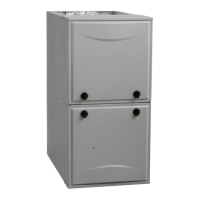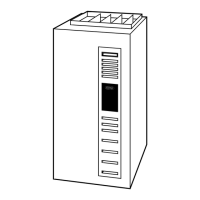4 + 1 BLOWER MOTOR FAULT – Indicates
the blower failed to reach 250 RPM or
the blower failed to communicate within
the prescribed time limits. Thirty
seconds after being turned ON or ten
seconds during steady-state operation.
Turn power off and check the following
items first before proceeding to the next
step.
- Rubbing blower wheel.
- Loose blower wheel.
- Wiring from furnace control to blower
motor.
Remove the R thermostat connection
from the furnace control, disconnect
both connectors from the blower motor
PL13 and PL14. Does the blower wheel
turn freely?
Replace the blower control module attached to
the blower motor. Follow the instructions with
the blower control module to make sure the
entire blower motor does not need to be
replaced.
Turn power back on. Is there 115VAC at
PL14-5 and PL14-4?
Youhaveanopenwireorbad
Is there 12-VDC at PL13-1 RED (+) and
PL13-4 GREEN (-)?
YES
NO
Is there 12-VDC at PL3-1 RED (+) and
PL3-2 GREEN (-)?
Replace the furnace control.
NO
Youhaveanopenwireorbad
terminal on either the RED or
GREEN wire between the
furnace control and the blower
motor.
YES
Is there 5-VDC at PL13-2 YELLOW (+)
and PL13-4 GREEN (-)?
Is there 5-VDC at PL3-3
YELLOW (+) and PL3-2
GREEN (-)?
NO
NO
Youhaveanopenwireorbad
terminal on the YELLOW wire
between the furnace control and
the blower motor.
YES
YES
The voltage just measured should be
very stable and should not fluctuate more
than .02-VDC. If the voltage fluctuates
more than this get a different voltmeter
before proceeding.
Turn power off, disconnect PL13 and
PL14 from the blower motor, then turn
power back on. Connect a DC voltmeter
across PL13-3 BLUE (+) and PL13-4
GREEN (-). The voltage should be near
0-VDC but it will fluctuate briefly several
times a second. If you have an analog
voltmeter the needle will briefly go high
several times a second. If you have a
digital voltmeter with a bar graph it will
show a large change in magnitude on the
bar graph several times a second. If you
have a standard digital voltmeter it will
show a brief fluctuation in voltage and the
magnitude may vary depending on the
voltmeter used.
Does the voltage fluctuate as described in the
previous step?
Connect a DC voltmeter across PL3-4 BLUE
(+) and PL3-2 GREEN (-). Does the voltage
fluctuate as described two steps back?
You have an open wire or bad terminal on the
BLUE wire between the furnace control and the
blower motor.
NO
Replace the furnace control.
YES
Turn power off, reconnect PL13 and
PL14 to the blower motor, then turn
power back on. Connect a DC voltmeter
across PL3-3 YELLOW (+) and PL3-2
GREEN (-). Does the voltage fluctuate
more than it did in the previous step?
NO
YES
YES
NO
Replace the blower control module attached to
the blower motor. Follow the instructions with
the blower control module to make sure the
entire blower motor does not need to be
replaced.
9 HIGH PRESSURE SWITCH
OR PSR RELAY DID NOT CLOSE OR
REOPENED -Check for:
- PSR relaymay be defective.
- Refer to status code #3.
10 POLARITY – Check for correct line
voltage polarity.
7 LIMIT CIRCUIT LOCKOUT – Lockout
occurs if the limit or flame rollout switch is
open longer than 3 minutes or 10
successive limit trips occurred during
maximum-heat. Control will auto-reset
after 3 hours. Refer to status code #4.
8 GAS HEAT ING LOCKOUT – Control will
NOT auto reset. Turn off power and wait
5 minutes to retry. Check for:
- Stuck closed gas valve relay on control.
- Miswire or short to gas valve BLUE wire.
4 + 3 LOW PRESSURE SWITCH OPEN
WHILE HIGH PRESSURE SWITCH IS
CLOSED - Check for:
- Low pressure switch stuck open.
- Disconnected or obstructed pressure
tubing.
- Improper pressure switch wiring.
- Low inlet gas pressure (if LGPS
used).
- Plugged condensate drain.
- Water in vent piping, possible sagging
pipe.
6 + 1 IGNITION LOCKOUT – System failed to
ignite gas and prove flame in 4 attempts.
Contact will auto-reset after 3 hours. Refer to
status code #6.

